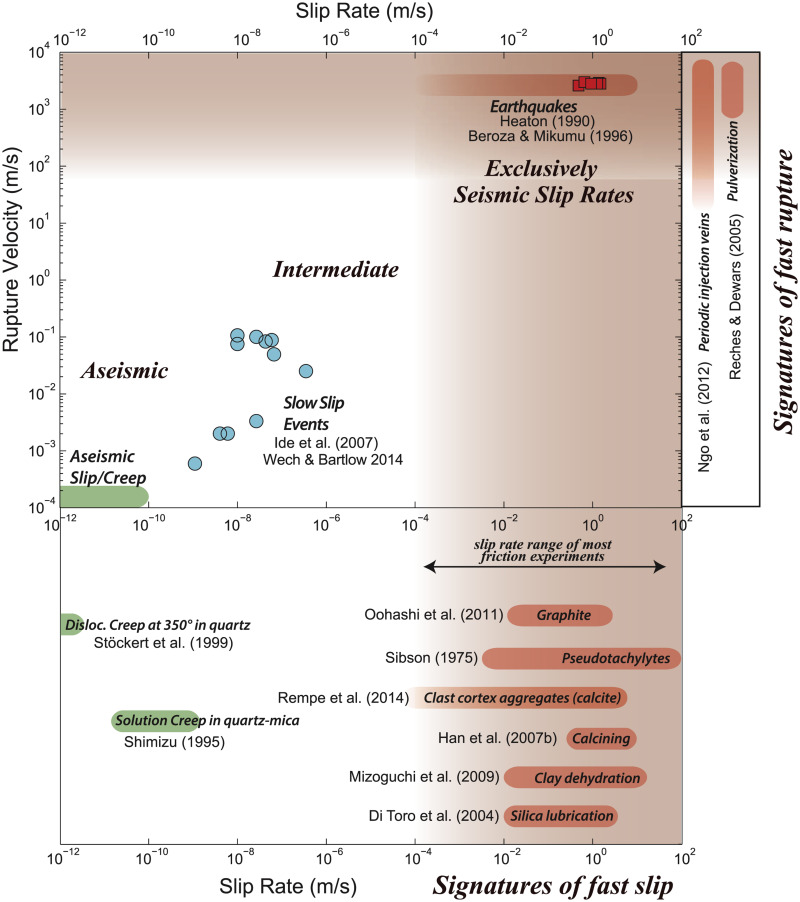
Earthquakes shake the Earth almost every day, but what exactly happens within rocks during these seismic events is a matter of debate in the scientific community. The article “Do faults preserve a record of seismic slip: A second opinion,” published in 2015, offers a thoughtful review of the sure and potential records of seismic slip in rocks.
The paper examines the notion that rocks in ancient faults, now exposed at the surface, act as archives of past seismic slip events. To begin, Rowan and Griffith summarize the characteristics of earthquakes. The presented information re-visits the influential works of Cowan (1999) and Sibson (1986), discussed in the article. First, the authors focus on the difference between fast slip and fast rupture (Fig. 1). While both occur during an earthquake, fast slip refers to the rapid movement along a fault, whereas fast rupture is the rapid propagation of the rupture itself. The processes at the rupture tip, rather than the slip rate, may sometimes determine whether the deformation is detectable by seismological methods.
The paper discusses first the definitive signatures of fast slip, including 1) frictional heating and pseudotachylites (a fine-grained rock type formed during earthquakes or other impact events), 2) frictional devolatilization, a process in which volatiles (such as water, carbon dioxide, or other gases) are released from minerals or rocks due to intense frictional heating, 3) the maturation of organic material and 4) the mobility of trace elements between fluids and rocks. Then, the article explores potential indicators of fast slip, such as fluidized granular flow, which is a type of crystal plastic deformation that occurs when granular material behaves like fluids due to the presence of interstitial gas or fluid, or from internal grain interactions.

Fig. 1. Slip rate and rupture propagation velocity for fast (seismic), intermediate (slow) and aseismic (creep) fault slip rates in active faults. Outside this plot, we show experimentally reproduced deformation mechanisms and their textural signatures, with constraints in either slip rate OR rupture velocity (after Rowe and Griffith, 2015).
Finally, the article delves into the diagnostic criteria for fast rupture velocity, distinguishing between those clearly induced by earthquakes and those that are more uncertain. Among the definitive indicators are injection veins and pulverization, while potential criteria include branching fractures, planar deformation features, and feather features (Fig. 2; mainly recognized in impact-shocked rocks).
Over the past 30 years, significant progress has been made in laboratory methods for detecting frictional heating as a proxy for fast slip, along with detailed micro- and nano-scale studies. These advancements provide a deeper understanding of the processes at play during seismic events. The article delves into this, by discussing the implications of experimental results to natural faults with an in-depth analysis of materials used in friction experiments. Slow slip events have been a major focus in the community over the last ten years, i.e. after the publication of this review (e.g. Bernaudin & Gueydan 2022; Giuntoli & Viola, 2022; Platt et al., 2024).

Fig. 2. Examples of a) planar features and branching features and b) feather fractures (After Reimold and Koeberl (2014).
The authors emphasize the need for interdisciplinary approaches that combine geological, geophysical, and modeling techniques to achieve a deeper understanding of fault behaviour. While stating that a field-based approach remains crucial in the study of faults, the authors also point out two significant remarks. Firstly, the spatial scale of outcrops rarely overlaps with the scale of geodetic observations, limiting our ability to make direct comparisons and observe heterogeneity in wall rock damage and fault core architecture. Secondly, geologists’ field observations strongly influence how complexity is reported to researchers who model chemical and physical processes. For example, the mechanical implications of complexity in fault splays have received little attention. To overcome this limitation, the authors suggest that simplifying outcrop data into fundamental interpretations would be essential to analyze earthquake-related problems.
Written by Gianluca Frasca, and the TS Must-Read Team
References
Bernaudin, M., & Gueydan, F. (2018). Episodic tremor and slip explained by fluid-enhanced microfracturing and sealing. Geophysical Research Letters, 45, 3471–3480. https://doi.org/10.1029/2018GL07758
Cowan DS (1999) Do faults preserve a record of seismic slip? A field geologist’s opinion. Journal of Structural Geology 21:995–1001. https://doi.org/10.1016/S0191-8141(99)00046-2
Rowe CD, Griffith WA (2015) Do faults preserve a record of seismic slip: A second opinion. Journal of Structural Geology 78:1–26. https://doi.org/10.1016/j.jsg.2015.06.006
Sibson RH (1989) Earthquake faulting as a structural process. Journal of structural geology 11:1–14. https://doi.org/10.1016/0191-8141(89)90032-1
Giuntoli, F., Viola, G. A likely geological record of deep tremor and slow slip events from a subducted continental broken formation. Sci Rep 12, 4506 (2022). https://doi.org/10.1038/s41598-022-08489-2
John P. Platt, Djordje Grujic, Noah J. Phillips, Sandra Piazolo, David A. Schmidt; Geological fingerprints of deep slow earthquakes: A review of field constraints and directions for future research. Geosphere 2024;; 20 (4): 981–1004. doi: https://doi.org/10.1130/GES02722.1
Reimold, W. U., & Koeberl, C. (2014). Impact structures in Africa: A review. Journal of African Earth Sciences, 93, 57-175. https://doi.org/10.1016/j.jafrearsci.2014.01.008

